EBS - Energy Harvester
Das Institut für Telematik experimentiert im Rahmen des Projektes EBS derzeit mit einer Reihe von Geräten, welche Strom aus Quellen wie Umgebungstemperatur, Vibrationen oder Flüssigkeitsströmungen erzeugen. Im Folgenden sind die charakteristischen Kennwerte dieser Geräte zusammengefasst.
Solarzelle
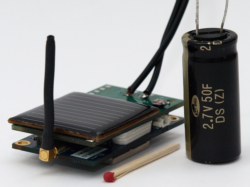 Solarzellen sind das wohl bekannteste und meist genutzte Verfahren zur Gewinnung elektrischer Energie aus der Umgebung. Dabei wandeln sie eintreffendes Licht in Elektrizität um, der Wirkungsgrad hängt jedoch stark von Intensität und Frequenzspektrum des Lichtes ab. Solarzellen lassen sich in verschiedensten Formen herstellen und lassen sich somit sehr gut in ihre jeweilige Umgebung integrieren. Aufgrund der langen Erfahrung und Verbreitung sind Solarzellen inzwischen auch recht kostengünstig.
Die von uns verwendete Konstruktion gibt bei voller Sonneneinstrahlung eine Leistung von bis zu 100 mW ab, im Schatten (Gebäude, Wolken) reduziert sich die Leistung auf etwa 15 mW.
Solarzellen sind das wohl bekannteste und meist genutzte Verfahren zur Gewinnung elektrischer Energie aus der Umgebung. Dabei wandeln sie eintreffendes Licht in Elektrizität um, der Wirkungsgrad hängt jedoch stark von Intensität und Frequenzspektrum des Lichtes ab. Solarzellen lassen sich in verschiedensten Formen herstellen und lassen sich somit sehr gut in ihre jeweilige Umgebung integrieren. Aufgrund der langen Erfahrung und Verbreitung sind Solarzellen inzwischen auch recht kostengünstig.
Die von uns verwendete Konstruktion gibt bei voller Sonneneinstrahlung eine Leistung von bis zu 100 mW ab, im Schatten (Gebäude, Wolken) reduziert sich die Leistung auf etwa 15 mW.
Wasserturbine
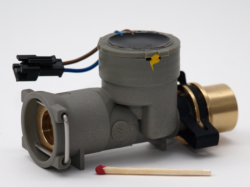 An vielen Stellen, an denen sauberes Wasser fließt, läßt mit Hilfe dieser kleinen Turbine (Kinetron WTG120) elektrische Energie gewinnen. So läßt sie sich z. B. im Kaltwasserzufluß eines Waschbeckens integrieren, wo sie zusätzlich noch als Ressourcen-sparender Durchflußmengenbegrenzer wirkt.
Ihren optimalen Wirkungsgrad hat diese Turbine bei einem Durchfluß von 2,5 l/min, bei dem sie eine Leistung von 227 mW abgibt, der Mindestfluß beträgt 2 l/min.
An vielen Stellen, an denen sauberes Wasser fließt, läßt mit Hilfe dieser kleinen Turbine (Kinetron WTG120) elektrische Energie gewinnen. So läßt sie sich z. B. im Kaltwasserzufluß eines Waschbeckens integrieren, wo sie zusätzlich noch als Ressourcen-sparender Durchflußmengenbegrenzer wirkt.
Ihren optimalen Wirkungsgrad hat diese Turbine bei einem Durchfluß von 2,5 l/min, bei dem sie eine Leistung von 227 mW abgibt, der Mindestfluß beträgt 2 l/min.
Vibrations-Harvester
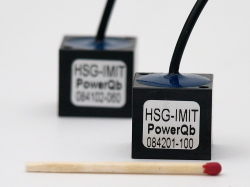 Der Prototyp PowerQb vom HSG-IMIT (http://www.hsg-imit.de/) wandelt Vibrationen in elektrische Energie, je nach Typ am effizientisten bei Frequenzen von z. B. 64,5 Hz oder 109,1 Hz. Somit lassen sie sich an vielen Stellen einsetzen, in denen sich eine Umgebung in mechanischer Schwingung befindet, z. B. in einem Kraftfahrzeug mit Verbrennungsmotor, in einem Lautsprecher oder an einem Kühlschrank mit Kompressorkühlung. Die erzielbare Leistung schwankt, je nach Typ, zwischen ca. 1,6 mW und 5,4 mW.
Der Prototyp PowerQb vom HSG-IMIT (http://www.hsg-imit.de/) wandelt Vibrationen in elektrische Energie, je nach Typ am effizientisten bei Frequenzen von z. B. 64,5 Hz oder 109,1 Hz. Somit lassen sie sich an vielen Stellen einsetzen, in denen sich eine Umgebung in mechanischer Schwingung befindet, z. B. in einem Kraftfahrzeug mit Verbrennungsmotor, in einem Lautsprecher oder an einem Kühlschrank mit Kompressorkühlung. Die erzielbare Leistung schwankt, je nach Typ, zwischen ca. 1,6 mW und 5,4 mW.
Thermo-Harvester
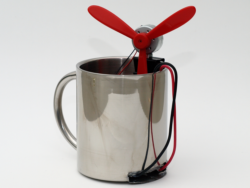 Seebeck-Elemente erzeugen elektrische Energie, wenn sie sich zwischen zwei Medien mit unterschiedlicher Temperatur befinden. So ist es möglich sie ein Geschirr einzubetten, in dem z. B. heiße Getränke serviert werden.
Seebeck-Elemente erzeugen elektrische Energie, wenn sie sich zwischen zwei Medien mit unterschiedlicher Temperatur befinden. So ist es möglich sie ein Geschirr einzubetten, in dem z. B. heiße Getränke serviert werden.
Tür-Harvester
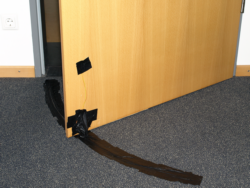 Eine Kette von Magneten mit alternierender Polung, eingelassen in den Boden unter einer Tür, kann eine darauf abgestimmte Kombination aus Spule und Metallkern angebracht an der Tür darüber so anregen, das durch die Spule Wechselstrom fließt, sobald die Tür geöffnet oder geschlossen wird.
Bei professioneller Einbettung in den Bodenbelag und die Tür spürt man keinen mechanischen Widerstand durch die Installation und auch keine ästhetische Beeinträchtigung.
Eine Kette von Magneten mit alternierender Polung, eingelassen in den Boden unter einer Tür, kann eine darauf abgestimmte Kombination aus Spule und Metallkern angebracht an der Tür darüber so anregen, das durch die Spule Wechselstrom fließt, sobald die Tür geöffnet oder geschlossen wird.
Bei professioneller Einbettung in den Bodenbelag und die Tür spürt man keinen mechanischen Widerstand durch die Installation und auch keine ästhetische Beeinträchtigung.
